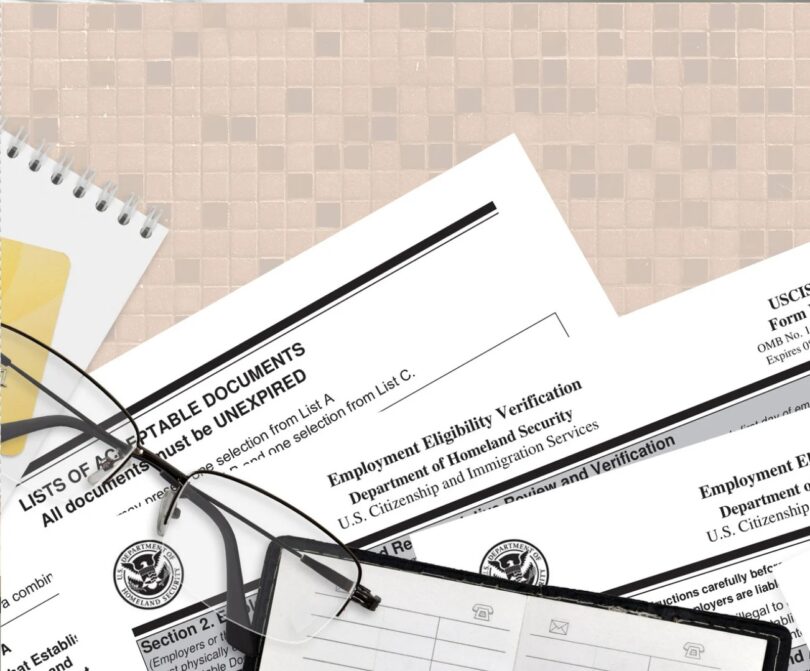The United States Citizenship and Immigration Services (USCIS) has updated Form I-9, which checks if someone can work. The new form uses the term “alien authorized to work” instead of “non-citizen authorized to work.” This may seem like a small change, but it is part of a larger shift in how federal documents are worded. It affects both employers and international workers.
Form I-9 is an important part of getting a job in the U.S. All employers must use it to check who a person is and if they are allowed to work. Every new employee, no matter their citizenship, must fill out this form when they start a job. Employers must look at the documents the employee provides, make sure they are real, and confirm they belong to the person they hired.
This article breaks down the main changes to Form I-9. It covers new terms, updated documents, and what employers must do to follow the rules.
What Is Form I-9?
Form I-9, also called the Employment Eligibility Verification Form, is a required document for all U.S. employers. They use it to check if a person they hire is allowed to work in the United States. The main goal is to make sure that everyone, whether a citizen or not, has legal permission to work.
By law, all U.S. employers must fill out and keep a Form I-9 for each person they hire. This rule applies to all businesses, big or small, in both the private and public sectors. Employees must also do their part by filling out their section of the form and showing valid documents that prove who they are and that they can work in the U.S.
The form is divided into three sections:
- Section 1 must be completed by the employee no later than their first day of employment. This section collects personal information and attests to the individual’s citizenship or immigration status.
- Section 2 must be completed by the employer within three business days of the employee’s start date. The employer must examine the employee’s documents and record the information to confirm work eligibility.
- Section 3, used for reverification or rehiring, applies when an employee’s work authorization expires or when they are rehired within a specified timeframe.
All employers must keep Form I-9 for a set amount of time and show it if government officials ask to see it. Following this rule is not optional. If employers don’t fill out or store the form correctly, they can face fines, audits, or other legal trouble.
Updates to Form I-9
The newest version of Form I-9 includes important changes that impact both employers and employees. These updates help match the form with current laws and federal rules. It’s important to understand these changes to stay compliant and keep the hiring process running smoothly.
Reinstatement of the Term “Alien Authorized to Work”
The biggest change is the use of the phrase “alien authorized to work” in Section 1 of the form. This replaces “non-citizen authorized to work.” The update brings the language in line with current immigration laws. Although some may find the term outdated or impersonal, it is still legally correct and matches the language in federal laws.
Changes in Document Descriptions (List B Updates)
Two documents in List B, which verify identity, have been updated with clearer descriptions. These changes help both employers and employees better understand which identification documents are acceptable. Employers should carefully check the updated list to make sure they only accept valid and properly described documents during verification.
Revised DHS Privacy Notice
The Department of Homeland Security (DHS) Privacy Notice in the form instructions has been updated. The new wording gives clearer details on how employee data is collected, stored, and used. This change improves transparency and ensures the form follows national privacy laws.
Alignment with Statutory Language
The updated Form I-9 is part of USCIS’s efforts to match immigration documents with current federal laws. Changes in wording and format help keep things consistent with immigration rules. This makes the form clearer and strengthens its role as a trusted way to check if someone is allowed to work.
Impact on International Workers
The updated Form I-9 includes language changes that impact how international workers show they are eligible to work. While these changes are mainly administrative, foreign nationals need to understand the new terms and their meaning to complete the form correctly and avoid confusion.
Clarification of Terminology: “Alien” vs “Non-citizen”
The phrase “alien authorized to work” now replaces “non-citizen authorized to work” in Section 1 of the form. Legally, both terms mean the same thing—they refer to people who are not U.S. citizens but are allowed to work in the country. The return of the word “alien” matches the wording used in immigration law. It doesn’t change a worker’s status, qualifications, or benefits.
Assurance That Legal Status and Work Eligibility Remain Unaffected
This change in wording does not affect a person’s immigration status or their right to work in the U.S. The rules for who can work stay the same. If an international worker was already allowed to work, that permission still stands. The update is only about language and does not change any benefits, rights, or responsibilities.
Perception and Cultural Sensitivity Considerations
The word “alien” is a legal term, but some people see it as old-fashioned or insensitive. In recent years, many government agencies have tried to use more inclusive language. Because of this, bringing back the word “alien” might feel like a step back to some. However, its use in Form I-9 is meant to match the wording in immigration law. It does not signal a change in policy toward non-citizens.
What International Workers Need to Know When Filling Out the New Form
International employees should read Section 1 of the updated form carefully. If they are not U.S. citizens or green card holders but have permission to work, they need to check the box that says “An alien authorized to work.” They must also:
- Provide the appropriate expiration date of their work authorization (if applicable).
- Submit valid documents listed under Lists A or B and C to verify identity and employment eligibility.
- Ensure that the information provided is accurate and matches the documentation presented.
Impact on U.S. Employers
The updated Form I-9 brings new rules that affect how U.S. employers check employee work eligibility. To stay compliant, employers must know their duties, switch to the new form on time, and update their systems and onboarding processes as needed.
Compliance Requirements Under the New Form
Employers must use the right version of Form I-9 to follow federal employment laws. The current approved form is dated 01/20/2025 and expires on May 31, 2027. By law, employers must use this form to check the identity and work eligibility of every new hire in the U.S.
System and Documentation Updates (Including E-Verify Systems)
Employers who use digital systems to fill out and store Form I-9 must update them to match the latest language and expiration date. Systems like E-Verify and E-Verify+ have also been updated to include the new term “alien authorized to work.” Employers must make sure their case-creation process in E-Verify follows the new wording to avoid delays or mistakes during verification.
Internal documentation protocols and employee handbooks should also reflect these updates to maintain legal alignment and reduce the risk of administrative errors.
Deadlines for Transitioning to the Latest Version
Employers must start using the updated Form I-9 by the date set by U.S. Citizenship and Immigration Services (USCIS). Older versions can still be used for a short time but will expire. For instance, employers using the 01/08/2023 version online must update their systems with the new expiration date by July 31, 2026. If they don’t switch to the new form on time, they could face penalties for not following the rules.
Frequently Asked Questions
What is the Main Change in the New Form I-9?
The primary change is the return of the phrase “alien authorized to work” in Section 1, replacing the previous term “non-citizen authorized to work.”
Does the Terminology Change Affect an Employee’s Legal Status?
No. The update is a change in wording only. It does not alter an individual’s legal work status or employment eligibility in the United States.
When Must Employers Start Using the New Version of Form I-9?
Employers must begin using the version dated 20/01/2025, with an expiration date of 31 May 2027, as soon as it becomes the mandatory form according to USCIS.
Conclusion
The updated Form I-9 brings several changes that impact both employers and international workers. These include bringing back the term “alien authorized to work,” updating the descriptions of identity documents in List B, and revising the DHS Privacy Notice. These updates help make the form match current laws and federal policy more closely.






